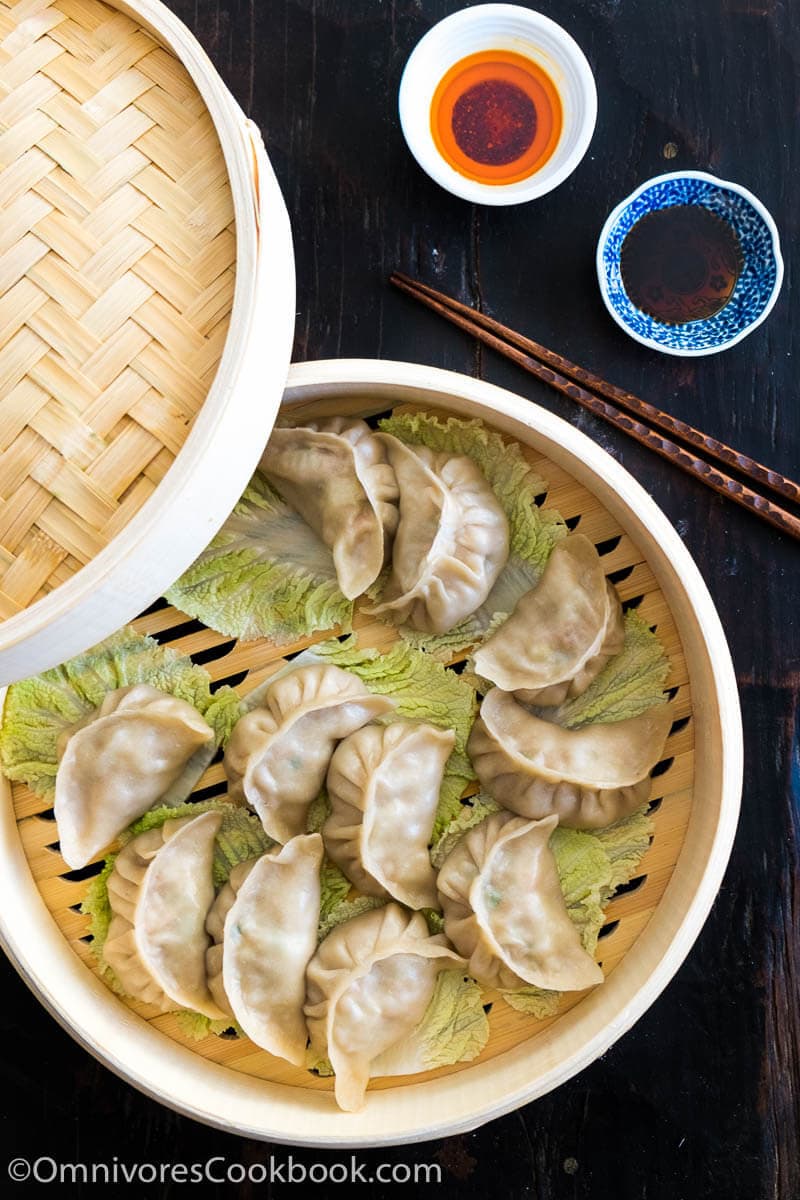
Since I wrote about how to make dumpling dough for boiled dumplings (the most common type in northern Chinese cuisine), I’ve received a lot of requests for steamed dumplings dough recipe.
In my last homemade dumpling post, I mentioned that dumpling making requires teamwork as it’s quite tough to work alone. However, the task seems less daunting even when you’re a one-person team in the case of steamed dumplings.
- Steamed dumpling dough is easier to roll and shape.
- You can make bigger dumplings, which equals less work.
- It won’t cause a big problem even if the dumplings didn’t seal tightly.
Steamed dumplings are a great starting point if you want to take up challenge of making fresh dumplings for the first time.
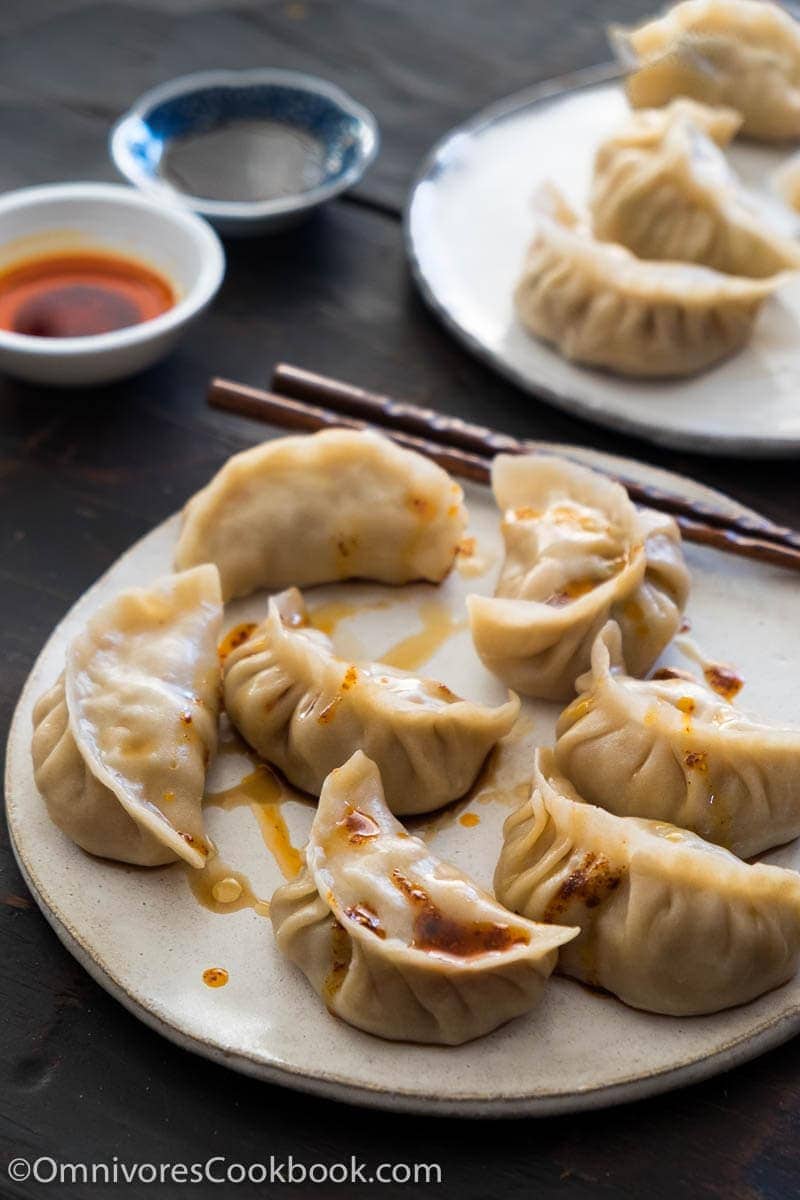
Steamed dumplings dough
To understand steamed dumpling dough, we need to look at boiled dumpling dough and why it’s different.
Water boiled dumplings (水饺, shui jiao) call for room temperature water to form the dough. In the process of adding water and kneading, the two major proteins in the flour – glutenin and gliadin, will form gluten. Gluten is a stretchy protein matrix which gives dough its structure, and resulting in a chewier texture once cooked. The more you knead the dough, the tighter and more elastic it becomes. Once you finish working with boiled dumpling dough, you need to let it rest for at least an hour or longer to allow the gluten to relax. Otherwise the dough will spring back when you stretch it, and be extremely difficult to roll out into a thin wrapper.
In the case of water boiled dumplings, we use the cold water dough so the dumplings will stay sealed during the cooking process. It results in slightly chewy dumplings that give a better mouthfeel.
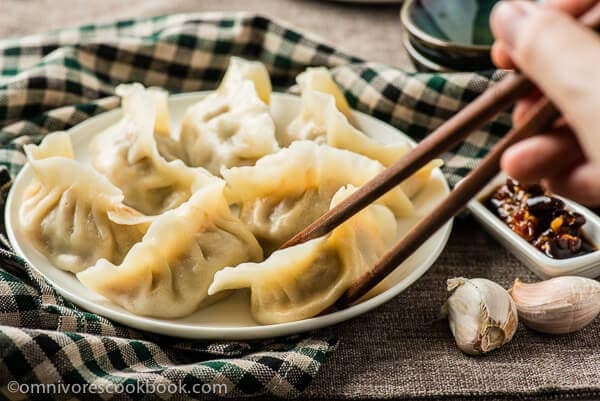
On the other hand, steamed dumplings use hot water dough (烫面, tang mian). By adding boiling water, you will cook the proteins and smash them into small pieces. In this process, the flour will end up absorbing more water but the texture of the dough remains tough. Due to the higher water content, the dumplings remain tender after steaming (the dumplings wrapper tend to taste very tough if you use cold water dough to make steamed dumplings). The finished dough will not be as stretchy and elastic as cold water dough. That’s why the dough is much easier to work with and roll out.
The beauty of steamed dumplings is that you can make slightly bigger dumpling wrappers without worrying them falling apart during cooking. For example, the standard boiled dumpling wrapper is about 7 to 8-cm (about 3”) in diameter, whereas the steamed dumpling wrapper can be 10 to 11-cm (about 4”) in diameter. You can make 80 boiled dumplings with 500 grams (1 pound) flour, but only about 45 steamed ones.
Steamed dumpling dough is great for vegetarian dumplings and dumplings filling with more vegetables (for example pork dumplings with cabbage). The larger wrapper makes the process easier, and you can add more vegetables into the dumplings to make them healthier.
Even if it is your first time wrapping dumplings and you cannot stuff a lot of filling into the wrapper, you still end up with a very decent and delicious result. If you’re hosting a dinner party, you can almost halve the working time because less wrappers need to be rolled and sealed. Even better, because of the low gluten development, you can work with the dough straight out of the fridge. You can prepare the dough ahead of time, and work on it anytime when you’re ready.
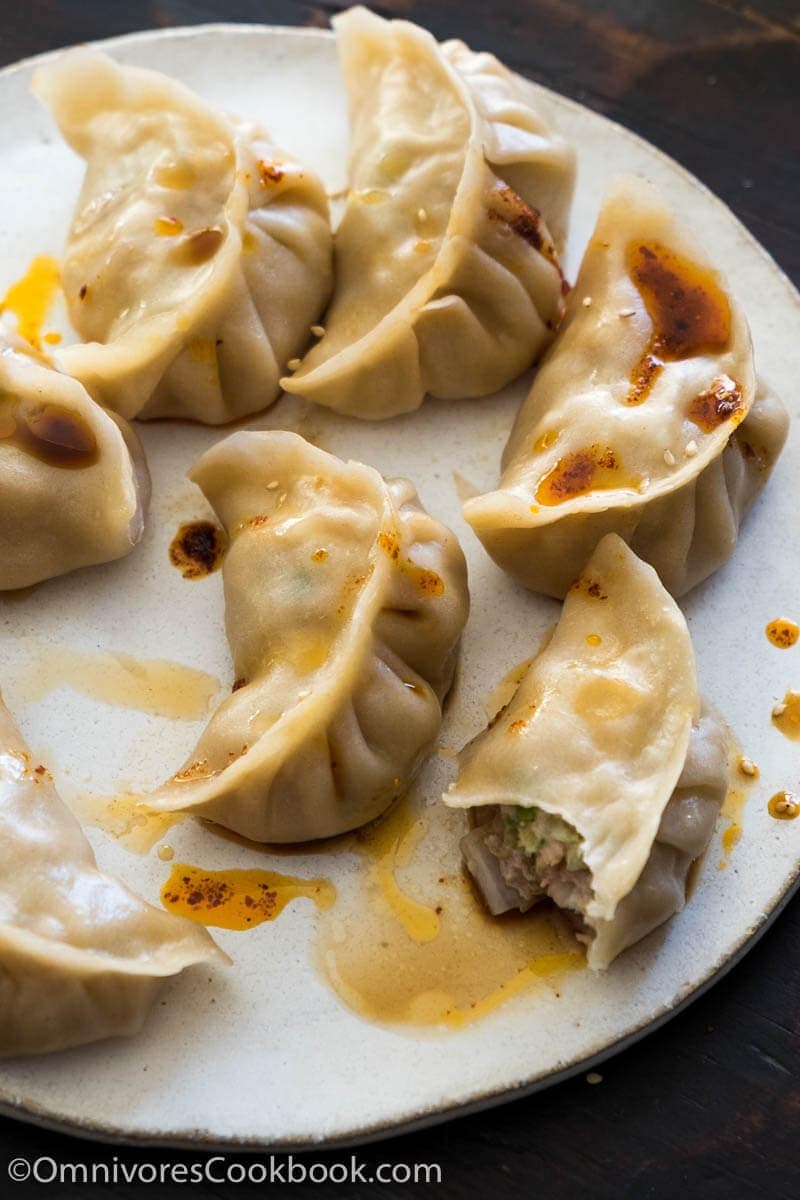
The workflow & cooking notes
There are a few things to keep in mind when it comes to making dumplings.
Dumpling filling
(1) Select ground meat that contain good amount of fat.
The majority of Chinese dumplings are made with ground pork, and many dumplings use lamb. They are both great in flavor and contain good amount of fat. I always make sure the ground meat contains at least 20% fat. You can use ground meat with higher fat content as well. The fat will keep the dumplings juicy and tender. If you use lean meat, the filling will end up tight and dry.
You can also choose ground chicken or beef with correct lean fat ratio. I personally like to use turkey meat instead chicken for dumpling filling because you can choose a fattier type (15% fat), and the meat itself is more flavorful. Most Chinese restaurants mix fatty pork into the chicken dumplings, to make them juicy enough. Same idea when using ground beef. Just like making burger, a fattier ground meat prevent the cooked meat from drying out.
(2) Another great way to create juicy and delicious dumpling filling is to add vegetables.
Ingredients such as carrots, bamboo shoots, bean noodles, corn, peas, and mushrooms are often added to create a more interesting texture. Vegetables that have a higher water content, such as napa cabbage, zucchini, and radishes, are often used to create a juicy filling.
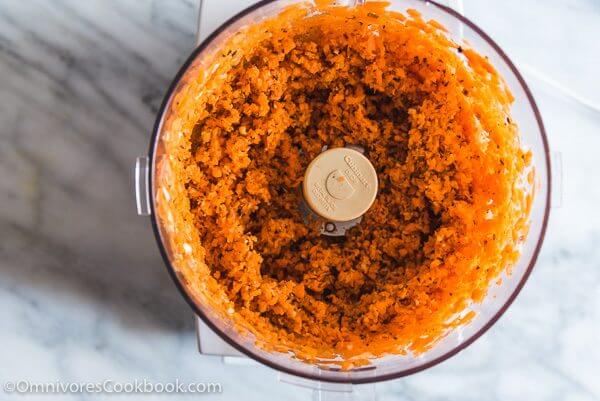
(3) Choose fresh ingredients and use only enough seasoning to bring out the flavor of the ingredients.
Just like cooking a premium cut of steak, you only need salt and pepper to highlight the steak itself. When making dumplings we usually use a few basic seasonings such as soy sauce, Shaoxing wine (very important), white pepper, salt, and sesame oil. You want to taste the freshness of the dough and the filling. Not overpower the dumplings with heavy seasonings.
(4) Marinate the ground meat a few hours prior to wrapping.
Marinating allows the seasonings to penetrate the meat evenly so the dumplings will be more flavorful without adding too much salt. Some seasoned cooks also beat ginger water into the ground meat during this step to make the filling juicer (same idea as injecting water into chicken before grilling).
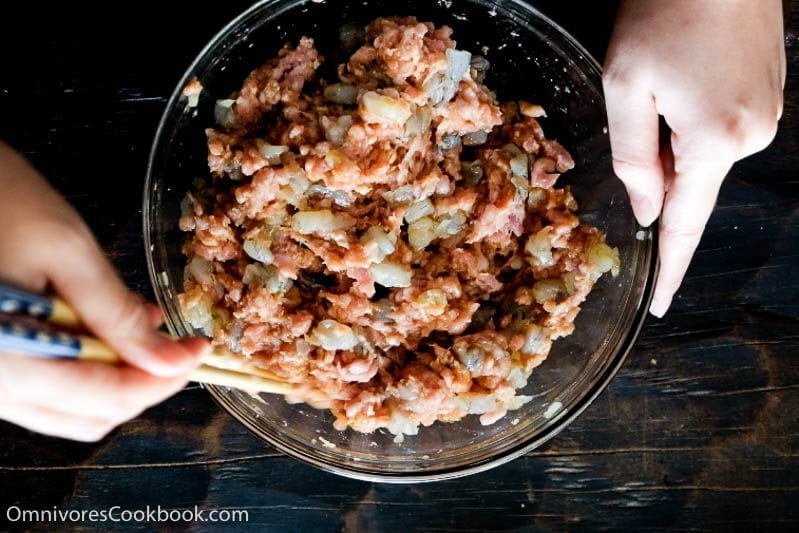
(5) Only add vegetables when you’re ready to wrap dumplings.
If you add them too early, the moisture from the vegetables will seep out due to the salt content, and cause the filling to become watery. It becomes difficult to work with the dumplings as the dumplings tend to fall apart during cooking.
(6) Create soup-dumpling-like texture.
We’re not talking the real soup dumplings (小笼包, xiao long bao), rather a juicy dumpling. It means, once the dumplings are just off the stove and still hot, you should see juice coming out of the dumplings after one bite. The juice won’t be as abundant as soup dumplings, but it tastes just as great. It is my favorite part when eating homemade dumplings.
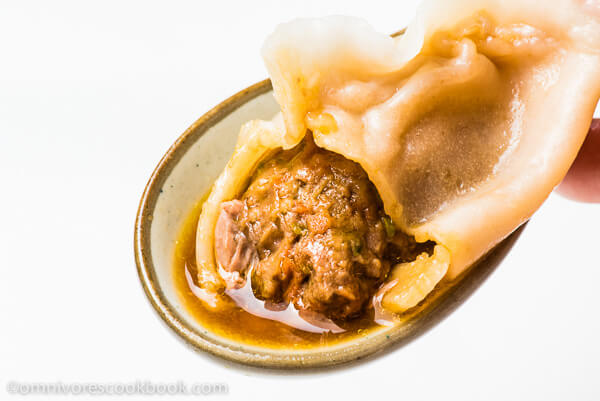
The juice comes from the vegetables and the fat content you add into the filling. My parents usually use high water content vegetables, such as zucchini and napa cabbage, without squeezing water out before adding them to the filling. You need to work on the filling very fast (usually with a team) before it turns watery. In return, you get “soupy dumplings” every time you make dumplings.
When I make the pork and cabbage dumpling recipe, I squeeze the water out to make the recipe easier. You’ll see in the picture below that the dumplings are quite juicy.
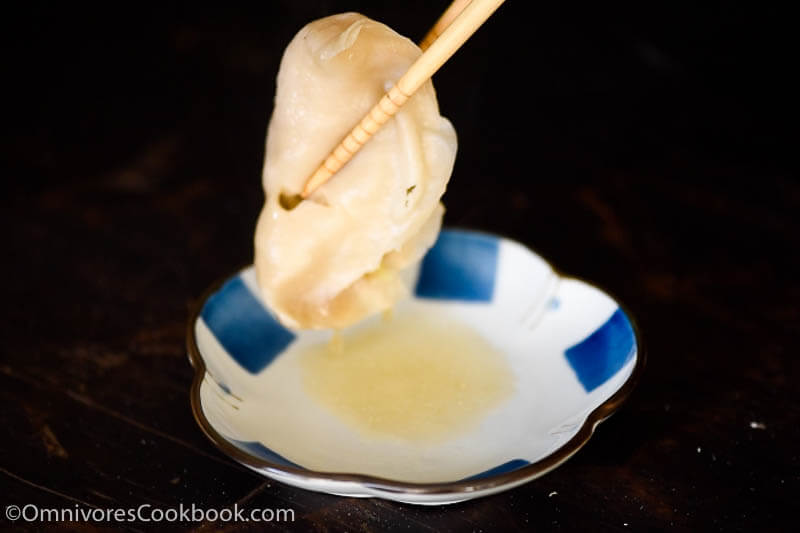
Dumpling dough
(1) You can either use a mixer or knead with your hands.
To learn the proper way to create the dough by hand, check out this video. Alternatively, I like to use my KitchenAid to knead the dough. It makes the task so much easier.
(2) When it comes to the texture of the dough, use your judgement instead of blindly following a recipe.
I’ve tried my best to use accurate measurements in this recipe. But depending on the flour, you might need to use more or less water. The best way is to judge is the dough flakes when the water is incorporated into the flour, and before they form a dough. If the dough flakes feel tough, flaky, and difficult to shape, add more water. If the dough flakes feel sticky and too tender, you can add more flour. Once the dough is formed, it’s easier to correct a soft dough by adding more flour than vice versa.
I’ve tried working with tender and tough dough. They both work. Soft dough is easy to roll, and the dumplings will turn out tender after cooking. But the wrapping process can be challenging and the dumplings won’t look very pretty. Tough dough is slightly more difficult to roll out, very easy to work with, and the cooked dumplings will look pretty. But they will be a bit chewier.
After a few tries, you want to adjust the dough texture according to your own taste and cooking habit.
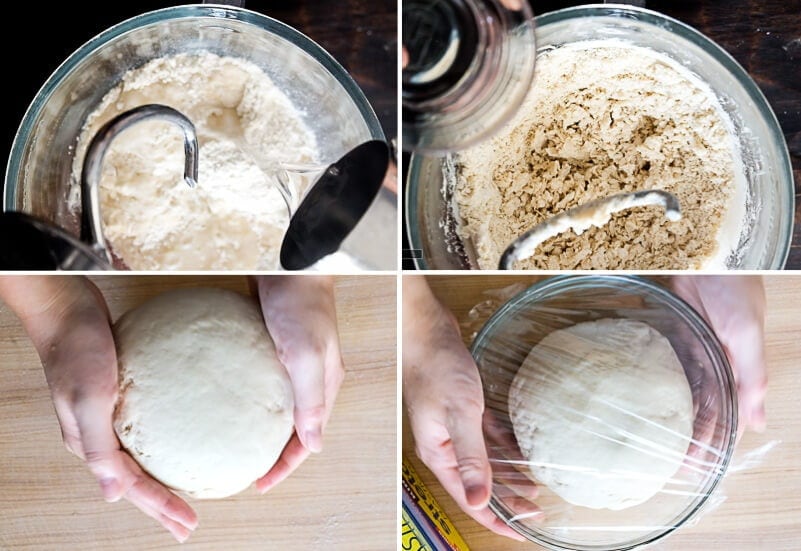
(3) Always remember to wrap the dough when not using it, and cover the dumplings wrappers to keep them from drying out.
Place the dough in a oiled bowl and cover with plastic wrap (or a clean wet towel) when you’re working on other things. Prepare a few layers of wet kitchen paper towel or clean towel, cover the dumpling wrappers immediately after rolling out. The dumpling wrappers will dry out very fast and become difficult to seal.
(4) Use the technique you’re comfortable with to make dumpling wrappers.
In the pictures below, I demonstrate the Chinese way to roll out dumpling wrappers. Unlike ravioli, we roll the dough into a long stick and divide them into portion sizes. Then, roll out each small dough piece by rotating the dough with one hand and rolling with the other hand at the same time. In the end you will get a paper thin round wrapper that is thick in the center and thin on the edge.
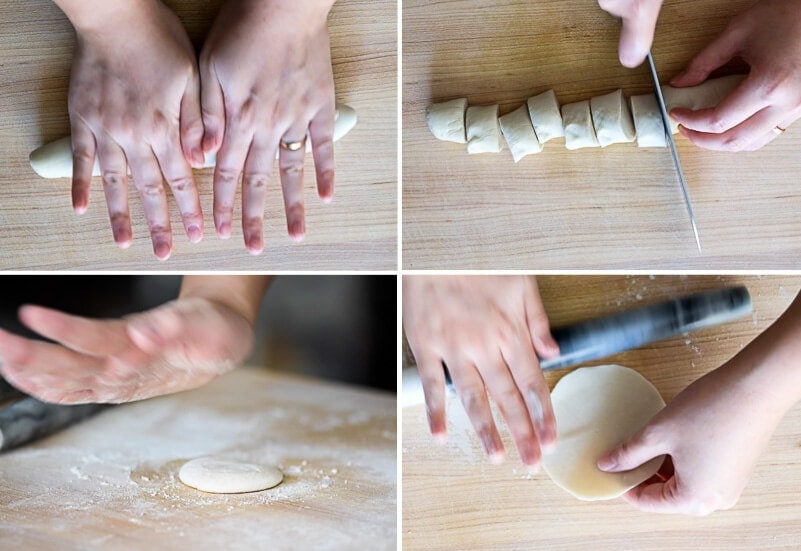
In the picture below you can see that the edge of the dumpling wrapper is almost transparent. Once you fold the pleats, the dumpling skin will have an even thickness, without heavy and thick pleats.
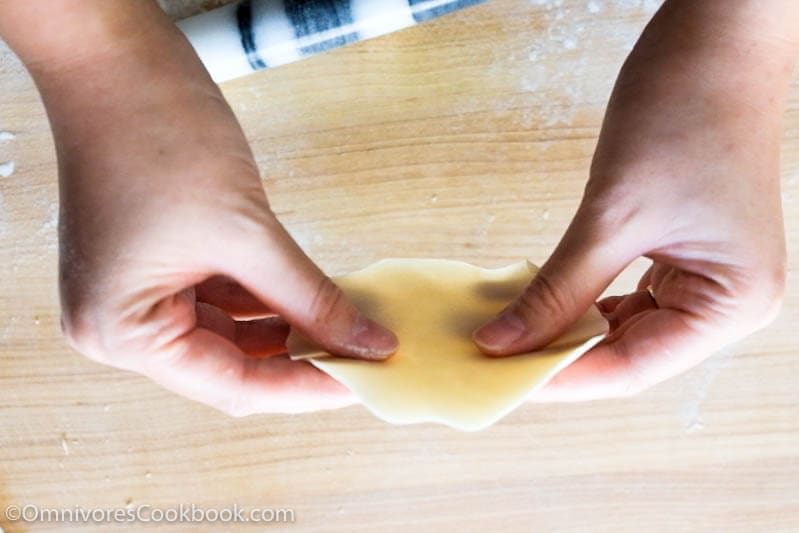
On the other hand, if you want your dumpling wrappers to be cut into evenly and in a perfect round shape, you can use a cup or a cookie cutter as well.
(5) Wrap the dumplings as soon as the wrappers are made.
Or preferably, at the same time if you can ask your family members to help. Unlike packaged dumpling wrappers, homemade ones are more tender and do not contain additives that prevent them from sticking together. That’s why the homemade dumplings taste so much better, and are healthier too. But they dry out easily and tend to stick together if you stack them for too long. Unlike packaged dumpling wrappers, you don’t want to use too much extra flour or starch to dust the wrappers once made (to prevent them from sticking), because it makes the dough texture tougher.
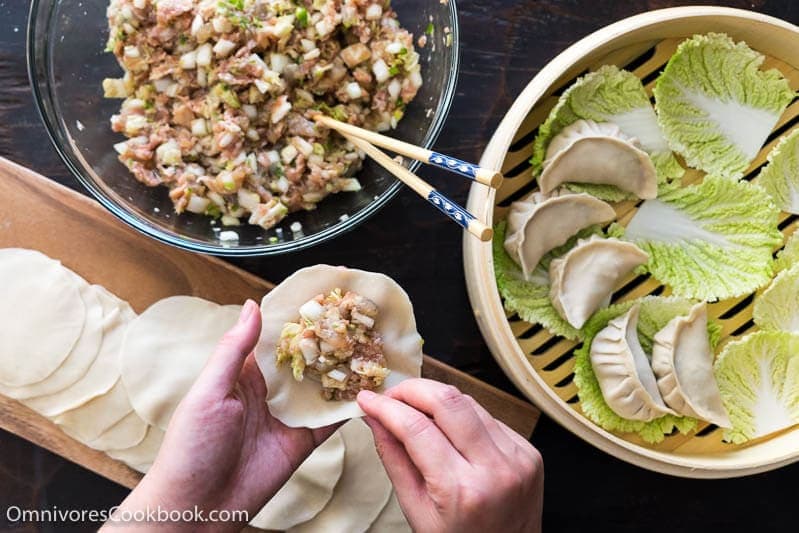
(6) How to store.
If you don’t serve the dumplings immediately it’s best to store the covered dough in the fridge until you’re ready to serve them. Or wrap dumplings and freeze them raw. Do not wrap dumplings and then let them sit on the counter until they dry out.
This is especially important if you want your dumplings soupy (see last point in “Dumpling Filling” part). If you freeze the dumplings soon after wrapping and steam them later, the filling will remain very juicy, just like fresh dumplings.
Cooking
The easiest step of all.
The traditional way is to use a bamboo steamer and cook the dumplings over a wok or a skillet. But a normal steaming pan or steaming rack works just as well. For better presentation and to prevent dumplings sticking to the pan, you can use napa cabbage leaves to line the steamer. You can also use a few layers of clean, wet cheese cloth too.
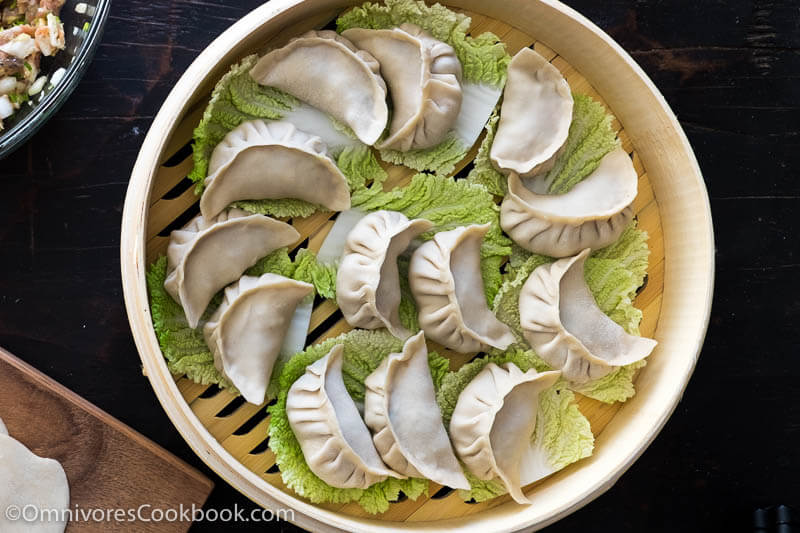
Always boil the water first before adding the rack of dumplings. Once you start cooking, do not uncover and peek inside. This releases the steam and causes a drop in pressure, which results in a longer cooking time.
Once steaming is finished, remove the steam rack from the pot first. Carefully uncover with a wet towel placed on the lid. The hot steam will come out immediately, so wait a few seconds before transferring the dumplings onto a plate to serve.
To cook frozen dumplings, steam directly without thawing. It takes 15 to 20 minutes depending on the size of the dumplings.
The steaming method does not require oil and keeps the dumpling juicy and intact, and does not impact the flavor of delicate dumplings.
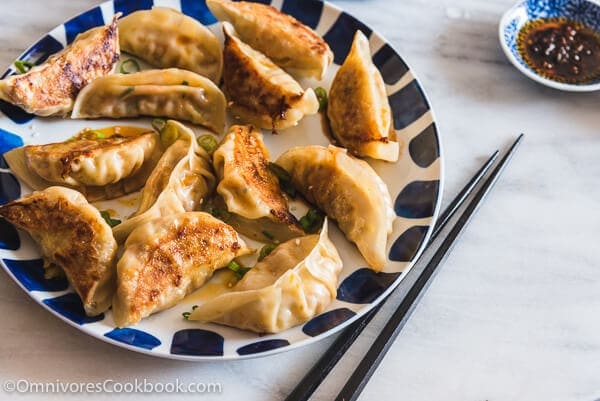
You can use this dumpling dough to make potstickers too. In China, potstickers is a way to deal with dumplings leftovers – we pan fry the cooked dumplings to heat them up. You can grill the roast dumplings in a skillet as well. Note that the size of the dumplings is much larger than normal potstickers, so you might need extra water, lower heat, and longer cooking time to cook through, and prevent the bottom from burning.
More dumpling recipes
For more dumpling filling recipes, check out my favorite lamb dumpling recipe, Pork and cabbage dumplings, vegetarian dumplings, and pork mushroom dumplings. Go to this page to learn how to make dumpling sauce.
I have another dumpling dough recipe for boiled dumplings.
Chinese Cooking Made Easy
Are you new to this website? This free email series is a great place to start. I’ll walk you through a few of my most popular recipes and show you how and why they work. You’ll quickly start to cook better Chinese food in your own kitchen.
Watch video
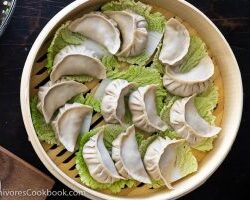
How to Make Steamed Dumplings from Scratch
Ingredients
Dumplings dough
- 3 cups all-purpose flour
- 1 cup boiling water
- 1/4 cup room temperature water
- 1 teaspoon vegetable oil
Dumplings filling
Dumpling sauce
Instructions
Marinate dumpling filling
- If you are using ground meat in dumpling filling add seasonings now to marinate the meat. Note, do not add vegetables at this stage. Cover the ground meat and marinate in the fridge for 1 hour to a day. Re-hydrate and prep dry ingredients if you’re making vegetarian dumplings.
Make dough with a mixer
- Attach dough blade to your mixer. Add flour into mixing bowl. Pour 1 cup hot water in the middle. Mix on low until the water is mostly incorporated. Stop mixer and scrape flour from the wall with a spatula. Mix on low until water is fully incorporated. Add room temperature water along the edge. Stir with spatula to mix. Start mixer on low until it forms a dough. If the dough won’t come together, keep adding cold water, 1 to 2 tablespoons at a time, until a dough is formed. The dough should be a bit springy, not sticking to the bowl, and not too tender. Add flour if the dough is too soft and doesn’t hold its shape. Keep kneading until the surface becomes smooth, about 10 to 15 minutes. Transfer to a working surface and knead a few times to shape into a dough ball.
Make the dough by hand
- Add flour into a large mixing bowl. Pour 1 cup hot water in the middle. Mix in a swirling motion to combine the flour in center of the bowl and leave some of the flour along the edge untouched. When the water is fully combined, add room temperature water along the edge in a swirling motion. Keep mixing until all the water is absorbed. Dust both hands with flour and start kneading to form dough. When dough has formed, dust the working surface with flour and dust hands again. Transfer the dough to the working surface and continue to knead it until its surface becomes smooth, about 10 to 15 minutes.
Rest the dough
- Brush a thin layer oil in a bowl and place the dough inside. Cover with plastic wrap and rest it for 30 minutes to 1 hour. If you don’t make the dumplings immediately, store the dough in the fridge for up to a day.
Mix the filling
- Now it’s the time to finish up the dumpling filling. Adding vegetables to the marinated ground meat. Finish with sesame oil. Mix well.
Prepare steamer
- Line a large steamer with napa cabbage leaves or a few layers wet cheese cloth.
- If you’re going to serve the dumplings immediately, add water to a large skillet or a wok. Bring it to the boil.
Make dumplings wrappers
- Divide the dough into 4 parts and roll into balls. Work on them one by one. Place the rest of the dough balls back in the bowl and cover with plastic wrap to prevent them from drying out.
- Shape and roll the dough into a long stick, about 20-cm (8-inch) length. Cut into 2-cm (2/3-inch) thick small pieces. You will get 10 to 12 pieces dough. I personally prefer to make large dumplings, so you can wrap in more fillings which are less work.
- Lightly dust both sides of each small dough with flour, and shape them into a cylinder. Work on them one at a time. Cover the rest with a few layers of wet kitchen paper towel to prevent them from drying out.
- Dust the working surface again. Take one dough ball and press it to a round disc. Roll with a rolling pin and rotate it a few times to thin out the dough. Then rotate the dough with one hand while rolling the dough with the other hand at the same time until it forms a round sheet (refer to the video to see how). Try to roll it so that that the edge is thinner than the center. The wrapper should be about 2 millimeters (1/16-inch) thick in center (i.e. almost same as the thickness of a CD), and paper thin on the edges. The diameter should be about 10 to 11-cm (4-inch). It is ok if the wrapper is not perfectly round.
Fold dumplings
- Starting here, you should work as quickly as you can because the wrappers will dry out quickly. Cover the wrappers with a few layers of wet paper towel to l prevent them from drying out too fast. If they do, you will find it difficult to seal the dumplings later. If the wrappers dry out when you start to fold the dumplings, brush a bit of water over the edge so you can still seal the dough.
- If you have a helper, they could start folding dumplings now, while you keep rolling the wrapper.
- Scoop about 2 tablespoons (or less, so you can easily fold the dumpling) of dumpling filling and place it in the center of the wrapper. Hold the dumpling with one hand and start sealing the edges with the other hand (refer to the video to see how to fold a dumpling). After folding, press edge again to seal well. You can use any way to fold the dumplings as long as you’re comfortable with it.
- If you’re going to cook the dumplings immediately, place them into the steamer, about 1 finger apart.
- If you’re going to cook the dumplings later, place them onto a baking tray and seal with plastic wrapper. Store dumplings in the freezer for up to 1 month. Once the dumplings are completely frozen, about a day, you can transport them to an air-tight container or a gallon bag to save freezer space.
Cook dumplings
- To steam dumplings, prepare the steamer by adding 2" (5cm) water to the steamer. Place the dumplings onto the steaming rack, at least one finger apart each other (the dumplings will expand a lot after cooking). Place the steaming rack onto the steamer and cover. Heat over medium heat until the steam comes out. Leave to cook, without peeking into the steamer, for 10 minutes or until the dumplings are completely cooked through.
- Serve immediately with dipping sauce. When the dumplings are just off the stove and still hot, carefully try one without any dipping sauce. The dumpling should have a lot of juice inside and be delicious and flavorful without any sauce.
Dipping sauce
- I introduced 4 types of dumpling sauce recipes in this post.
Storage and reheating
- The best way to store is to freeze uncooked dumplings immediately after wrapping. Steam frozen dumplings without thawing until they’re cooked through, 15 to 20 minutes.
- If you have leftover cooked dumplings, store in airtight container in the fridge and consume within 1 to 2 days.
- To reheat in microwave – Add dumplings into a bowl and sprinkle with a few drops of water. Cover and heat until warm.
- To reheat by steaming – Just like steaming the raw dumplings, cook dumplings in a steamer until heated through, about 5 minutes.
- To pan fry – Grease a nonstick skillet with a thin layer of oil and heat over medium heat. When skillet is hot, add dumplings. Swirl in a tablespoon of water, cover immediately, and cook for 2 to 3 minutes.

Did you make this recipe?
I’d love to hear how it turned out for you! Please take a moment to leave a 5-star rating ⭐️ and share your thoughts in the comments further down the page. It really helps others discover the recipe too.

hibah
hi! can i use store bought wrappers with the steaming method? will they cook through?
Maggie
Yes, that totally works! You might need to adjust cooking time slightly depending on the size of the wrapper you get, but yeah the ingredients will cook through.
Sylvie
Brilliant recipe and instructions. I made pork dumplings for the very first time and as i couldn’t find ready made wrappers, i ventured into doing the dough from scratch. Details, comments and video made it very straight forward and I got a big thumbs up from my family who enjoyed them for our NY eve dinner!
I will have to practice the crimping but I enjoyed the process so much that I will definitely do it again.
Thank you so much, I wish you a Happy New Year and look forward ro trying your other recipes
Bin
I love dumplings, but I don’t have time to make dumpling skin from scratch. Do you have a brand that you recommend to buy for boiled dumplings?
Thank you!!
p.s. love your recipes and your style!
Maggie
If you use store-bought dumpling wrappers (any brand), I wouldn’t boil the dumplings because they will fall apart.
You can use the pan fried method or steamed method instead: https://omnivorescookbook.com/steamed-dumplings/
Tracy
This is an amazing recipe!!! I made the steamed dumpling dough and pork/cabbage filling for the first time. The taste is beyond amazing!!!
I loved this dough, it was extremely forgiving to work with. Thank you SO much for sharing!!!!!
I had extra dough left over (I ended up making two batches of dough). Would it be ok to freeze the dough & use it at a later date, or would it not be good to work with later?
Maggie T.
I really enjoyed the dumplings. Pork flavour was so delicious. In fact, it was so similar to the local restaurant I just ordered the night before. My only question is, the dough was a little too chewy. I did it by myself so perhaps I left the dumplings sitting (covered with a wet paper towel) too long before I finished them and steamed them? It was my first time making dumplings. Will definitely make it again. Thank you so much for sharing!
Maggie
If the dough tastes very dry after steaming, it’s probably because they sit too long and the dough dried out. But I think the wet paper towels should help as long as the dumplings don’t sit for too long. If you’re steaming the dumplings by batches, I would recommend to start steaming half way through the wrapping, so the dough stays fresher.
Caitlyn Cole
It came out o good! The rolling out part took forever but since I’m new to it and doing it alone, I wouldn’t expect anything else. Can’t wait to do it again.
MATTHEW J VESELY
How do you marinate the meat? I don’t see much in the way of ingredients.
Maggie
Hi Matthew, you don’t need to marinate the meat to make dumpling fillings.
Prachi
I MADE THESE. and they changed my life!
jessie wright
These were so much fun to make and they came out amazing.
A few questions for you:
I can’t get high fat pork in my country, do you think if I just add a little veggie oil to the meat that will do the trick?
Also, when storing in the fridge to eat the next day, is it best to let them cool before putting them in a container, or will they dry out. If I put them in warm will they stick? Do I need to put wax paper between them? Should I store them with a little water/broth in the container?? Lastly, I ran out of filling before I finished using all the dough. Can I freeze the dough? Would it be best to roll the wraps out and then freeze them or freeze the whole lump of dough??
Thanks!
Maggie
Hi Jessie, I’m glad to hear you liked the recipe!
To answer your question, if you cannot get fatty pork, the lean type would work just fine. I think a bit veggie oil would help to keep the filling moist, but you don’t need a lot. The veggie will create a juicy filling anyway.
For the leftovers, I would let them cool a bit and put them in a container. The wrapper would try out if you let them sit outside for too long. The dumplings would stick together no matter what, but yeah, wax paper would help and it’ll be better not stacking too much in a big container. But you can separate them later when reheating. I would not add water to the container. It makes the dough too soggy. The best way to reheat is to steam them until they are heated through, just like when you cook them. They will taste the moist juicy this way without the skin drying out. You can even pan fry them with a bit oil to make them crispy.
I’ve not try to freeze the dough in the past but I can’t see why not. It’s not a yeast dough and should work after thawed.
kafeimai
Hi Maggie.
Thanks for the recipe, the pictures left me salivating.
Vincent Bezuidenhout
Amazing! Easy to follow and turns out brilliantly!
Sam
This dumpling wrapper is incredible!!! It’s just like you would get from the restaurant!!! It’s got the right amount of Chew and flavor and the texture is amazing. Just the feel of the dough in your hands is amazing! I’ve tried a few different types of dumpling wrapper recipes and this is the best one!!! I had some filling left over from a different recipe but can’t wait to try your filling since the wrapper was so amazing! Yum yum yum!!! I suck at sealing them and making the pleats but they some how look better once cooked??
Jackie
Hello! I love to make EVERYTHING from scratch, and I can’t wait to try this dumpling dough. I’m curious…how does this dough differ from that used for Korean mandu? Do you know if it is the same? I took a university-level Korean cooking class when I was living in Seoul, but even the instructors used purchased mandu wrappers. I’d love to make it from scratch, and I’d be even happier to find out it is basically the same as your recipe, with the difference being the fillings! Thank you in advance!
Maggie
Hi Jackie, yes, the dumpling wrapper is basically the same with Korean mandu. It is good for steamed and pan fried dumplings.
However if you like water boiled dumplings (or mandu), I do have a different wrapper recipe: https://omnivorescookbook.com/recipes/how-to-make-chinese-dumplings
The only difference is the water. The pan fried / steamed type uses warm water dough, and the boiled type uses cold water dough.
I hope this answers your question!
Happy cooking and can’t wait to hear your feedback! 🙂
Karen Thompson
I’m so glad to find your site, Maggie. I’ve never made dumplings before but got in the mood tonight and found your recipe and instructions. So helpful. My goal was to use up some leftovers, so I followed your dough recipe and instructions to build and steam the dumplings, but I concocted a filling of ground-up leftover beef and vegetable stir fry (that was very flavorful and moist), shredded leftover cooked chicken, and shredded Romaine lettuce (because I had no cabbage). You know what? It was great and the kids came back for more. I made a simple dipping sauce of soy sauce and vinegar. I have no idea if this would pass muster in a Chinese kitchen, but it was pretty cool in my Irish-American one. 🙂 Thanks for posting this!
Maggie
Hi Karen, thanks for taking time and leaving a comment! Your dumpling filling sounds very interesting and yummy! There are endless ways to make dumpling filling. Growing up in Northern China, we usually use raw ingredients in the dumplings. But I do know many parts of China opt for cooked food for the filling. I’m glad to hear you and your kids enjoyed them! So happy to spread the love of Chinese food 🙂
Joanna Flood
Hi, Maggie. Just found your website couple days ago. I love your recipes! They really made my Chinese food memories come alive again! I mean real Chinese food in China.
Just tried this recipe for dinner. whole family love it. Definitely save this recipe in my box!
I did adjust recipe a little bit. Just for sharing with you. I didn’t really squeeze the cabbage juice out, which made the filling juicy. It really depends on how fat the ground pork you use. I used to mix some water or extra cooking oil in dumpling filling if I use lean ground meat. Otherwise, the filling may be too dry.
Anyway, love your website! Thank you for sharing these recipes with me!
Maggie
Hi Joanna, I’m so glad to hear you cooked with my recipe and enjoyed the dish!
Yes I definitely agree with you that not squeezing out the juicy from cabbage will make the dumplings juicier. When I developed this recipe, I tried to make the filling a bit easier to deal with, so the majority of my readers won’t find it too challenging to wrap. When I use lean ground meat, I add some stock and more oil too. My mom also told me a trick of creating ginger infused water instead of using ground ginger. They all work very well.
Thanks for taking time to share your cooking experience. Hope you find more recipes to try out 🙂
Pat C.Wilson
yea can’t wait to try this recipe, Maggie. I love Chinese foods and the meticulous way of making them. thanks for sharing 🙂
Tricia @ Saving room for dessert
I would love to try this Maggie – it looks and sounds wonderful. Thanks so much for these creative and mouthwatering authentic recipes!
FABIOLA
Hello,
Is it possible to freeze the wrappers to fill them another day?
Maggie
I’d suggest you to wrap the dumplings right after rolling the wrappers and freeze the uncooked dumplings. It is much easier to do that way and the dumplings will be fresh and ready the day you serve. We don’t usually freeze the wrappers because they tend to stick together after thawing.
Eva
Can’t wait to try making the dumplings. I am one of those who requested a recipe.
I don’t have a mixer with a dough hook. I’ll try making the dough by hand but I wondered if you tried to use a food processor? I wondered about pouring the boiling water into the flour while the processor is spinning the flour. Have you tried that?
Maggie
Hi Eva, I haven’t tried a food processor for this recipe yet but I think it will work. Do not pour the boiling water while the processor is spinning. Pour the hot water at once and then start the processor. Then You can pour in cold water while the processor is spinning. The idea is cook a partial of the flour and then mix in cold water, so the dough will be easier to work with.
Happy cooking Eva, and hope the dumplings turn out delicious 🙂
Helen @ Scrummy Lane
I’ve always wanted to try making Chinese dumplings. I’ve got a bamboo steamer, but have only ever cooked ready-made buns in them.
Time to be brave and try making my own! Thank you for the brilliant tutorial, Maggie!
Maggie
Hi Helen, happy to hear you like dumplings too! If you ever plan to make dumplings at home, definitely try it with your family or friends. It’s way more fun when you challenge it with a team 🙂